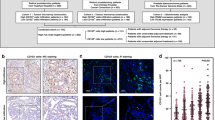Abstract
Introduction
CD47 over expression has been reported in several tumor subtypes. CD47 interacts with SIRPalpha on macrophages inhibiting phagocytic signal, providing a survival advantage to tumor. CD47, therefore, represents a valuable target for immunotherapy and is currently under clinical investigation. We aimed to study CD47 expression in Hodgkin Reed Sternberg cells (HRS).
Methods
We tested a polyclonal CD47 antibody (LifeSpan Biosciences, Seattle, WA) expression along with classical HRS cell markers on a tissue array of 16 classical Hodgkin Lymphoma (CHL) tumor biopsies obtained from newly diagnosed, non-selected patients (8 Female, 8 Male patients) in our institution from October 2016 to January 2018. Histologic subtypes were nodular sclerosis in 11 cases, mixed Cellularity in 3 cases and lymphocyte rich in 2 additional cases. Median age was 53 years (Range: 8, 74). Early stage disease was found in three patients without unfavorable prognostic factors according to EORTC and GHSG criteria, one patient with unfavorable prognostic factors and nine patients had advanced disease. Bulk disease was present in one patient. Normal lymphoid tissue and normal prostate epithelium were used as normal controls as recommended by manufacturer. Approval from the Local Ethical committee was obtained before any analysis.
Results
CD47 was overexpressed on all HRS cells with a characteristic dot-like pattern in 13/13 cases of CHL. HRS clearly expressed CD47 more intensely than infiltrating T and stromal cells.
Discussion
We propose that HRS cells, by up-regulating CD47, might avoid innate immunity check on tumor growth, which could be circumvented using blocking monoclonal antibodies.


Similar content being viewed by others
References
Brown EJ, Frazier WA. Integrin-associated protein (CD47) and its ligands. Trends Cell Biol. 2001;11(3):130–5.
Matozaki T, Murata Y, Okazawa H, Ohnishi H. Functions and molecular mechanisms of the CD47-SIRPalpha signalling pathway. Trends Cell Biol. 2009;19(2):72–80.
Zhao XW, van Beek EM, Schornagel K, et al. CD47-signal regulatory protein-α (SIRPα) interactions form a barrier for antibody-mediated tumor cell destruction. Proc Natl Acad Sci USA. 2011;108(45):18342–7.
Chao MP, Weissman IL, Majeti R. The CD47-SIRPα pathway in cancer immune evasion and potential therapeutic implications. Curr Opin Immunol. 2012;24(2):225–32.
Liu X, Kwon H, Li Z, Fu YX. Is the CD47 an innate immune checkpoint for tumor evasión? J Hematolo Oncol. 2017;10(1):12.
Pardoll DM. The blockade of immune checkpoints in cancer immunotherapy. Nat Rev Cancer. 2012;12(4):252–64.
Willingham SB, Volkmer JP, Gentles AJ, et al. The CD47-signal regulatory protein alpha (SIRPa) interaction is a therapeutic target for human solid tumors. Proc Natl Acad Sci USA. 2012;109(17):6662–7.
Liu X, Pu Y, Cron K, et al. CD47 blockade triggers T cell-mediated destruction of immunogenic tumors. Nat Med. 2015;21(10):1209–15.
Vonderheide RH. CD47 blockade as another ckeckpoint therapy for cancer. Nat Med. 2015;21(10):1122–3.
Majeti R, Chao MP, Alizadeh AA, et al. CD47 is an adverse prognostic factor and therapeutic antibody target on human acute myeloid leukemia stem cells. Cell. 2009;138(2):286–99. https://doi.org/10.1016/j.cell.2009.05.045
Chao MP, Alizadeh AA, Tang C, et al. Anti-CD47 antibody synergizes with rituximab to promote phagocytosis and eradicate non-Hodgkin lymphoma. Cell. 2010;142(5):699–707.
Lian S, Xie R, Ye Y, Lu Y, Cheng Y, Xie X, Li S, Jia L. Dual blockage of both PD-L1 and CD47 enhances immunotherapy against circulating tumor cells. Sci Rep. 2019;9:4532.
Funding
This research was funded by Mutual Médica (Grant No. Trabajo financiado con el premio de accésit a la Beca Mutual Médica del año 2016).
Author information
Authors and Affiliations
Corresponding author
Ethics declarations
Conflict of interest
The authors declare that they have no conflict of interest.
Ethical approval
The study was approved by the local Ethical Committee of the Central University Hospital of Asturias. All patients enrolled provided written informed consent.
Informed consent
All patients enrolled provided written informed consent.
Additional information
Publisher's Note
Springer Nature remains neutral with regard to jurisdictional claims in published maps and institutional affiliations.
Electronic supplementary material
Below is the link to the electronic supplementary material.
Rights and permissions
About this article
Cite this article
López-Pereira, B., Fernández-Velasco, A.A., Fernández-Vega, I. et al. Expression of CD47 antigen in Reed–Sternberg cells as a new potential biomarker for classical Hodgkin lymphoma. Clin Transl Oncol 22, 782–785 (2020). https://doi.org/10.1007/s12094-019-02171-2
Received:
Accepted:
Published:
Issue Date:
DOI: https://doi.org/10.1007/s12094-019-02171-2




